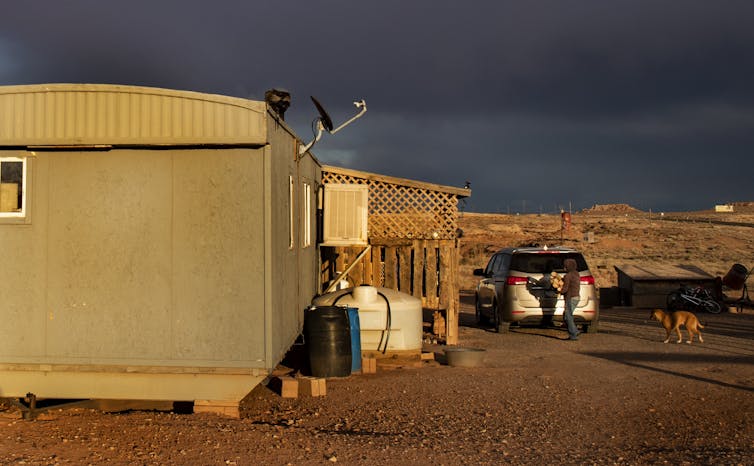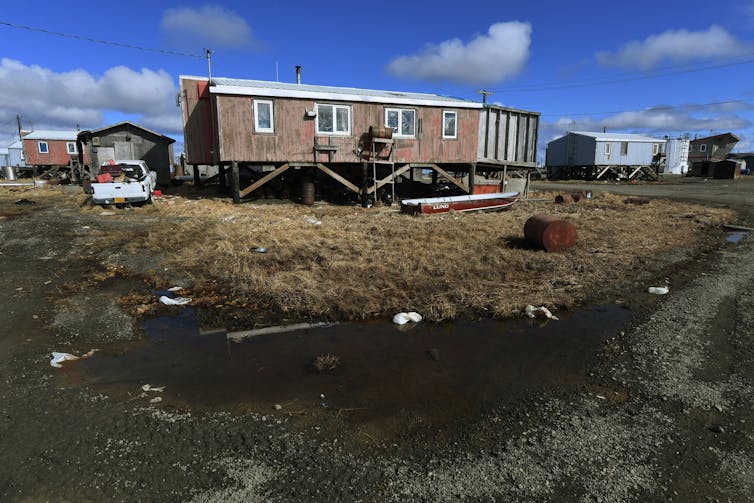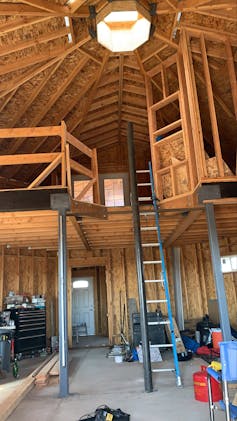Fixing indoor air pollution problems that are raising Native Americans' COVID-19 risk
- Written by Lisa Hardy, Associate Professor of Anthropology and Director of the Social Science Community Engagement Lab, Northern Arizona University
Betty’s home stands on the edge of a striking red cliff. Her family built the home from materials in their environment generations ago and passed it along from mothers to daughters. But it is cold, and the home is small with few windows. Insufficiently ventilated homes in these areas can have high levels of particulate matter, dust, mold and radon[1], a naturally occurring gas that can cause lung cancer.
Rosa, a great-grandmother, lives in her family home with a large wood-burning stove. On one wall are colorful paintings representing her clan lineage. On another wall, black stains show where an exhaust vent was improperly installed.
Both women live in homes full of meaning and tradition in the Southwest, a region that is home to 574 recognized tribes[2]. And both face a serious health risk: poor indoor air.
Poor indoor air quality has been linked to health hazards[3] for decades and is an ongoing problem[4] in American Indian communities. Fine particulate matter and inhalation of other pollutants contributes to high risk for influenza[5], for example.
Research in the U.S.[6] and other countries[7] now suggests that long-term exposure to air pollution can worsen the chances of having serious complications from COVID-19. Indeed, American Indian and Alaska Natives face hospitalizations and death from COVID-19 at higher rates than any other racial or ethnic group[8].
Tribes have been taking measures to curb the spread of COVID-19, including enacting stronger prevention measures and rolling out vaccinations more effectively than many states, yet fixing the underlying problems that put people at high risk remains challenging. In response, Native communities are exploring clean energy options and working on improving solutions that weave together meaningful home design and safer, cleaner air.
 A stove for heating stands in the center of a hooghan, a traditional home, in Arizona.
AP Photo/Carolyn Kaster[9]
A stove for heating stands in the center of a hooghan, a traditional home, in Arizona.
AP Photo/Carolyn Kaster[9]
As a medical anthropologist[10], archaeologist[11] and family medicine doctor and public health professional[12], we are concerned about the past, present and future of clean air and the reduction of environmental pollution. Indoor air pollution is part of larger issue of health and safety in Native communities.
Understanding the structural barriers to good health can help explain why COVID-19 affects tribes more severely. And these risks won’t leave with the pandemic.
The problem of indoor air pollution
A view from the sky would appear to show clean air in rural areas where many Native people live. But a closer look reveals a different story: environmental pollution inside homes, schools and other buildings.
The reasons for poor indoor air on tribal lands are vast and complex. In many ways, the burden of dispossession endures.
 A Navajo woman carries wood to heat her rural mobile home in freezing temperatures during the coronavirus pandemic.
Gina Ferazzi/Los Angeles Times via Getty Images[13]
A Navajo woman carries wood to heat her rural mobile home in freezing temperatures during the coronavirus pandemic.
Gina Ferazzi/Los Angeles Times via Getty Images[13]
In parts of the Southwest, many people rely on coal and wood-burning stoves[14] that have been linked to respiratory disease[15]. Electric heat isn’t an option in the thousands of homes that aren’t connected to a power grid[16].
Homes in some rural areas are at high risk for developing mold or having radon[17], carbon monoxide[18] and other environmental contaminants. Radon and mold remediation is costly, and repairs and maintenance can be difficult when it’s hard to find licensed contractors. Long distances to hardware stores can make it challenging to obtain supplies and maintain repairs.
In homes without stoves or electricity, the only option may be propane, which can release a host of pollutants into the air when used for heating or cooking.
Leaving behind ancestral homes is a bad solution to the problem. In the past, people were encouraged to leave homes for trailers[19] funded by the Department of Housing and Urban Development and the Bureau of Indian Affairs up until the 1970s. However, these homes are poorly suited for long-term living. The trailers have thin walls and poor ventilation, making them hot in summer and cold in winter, and low-quality materials don’t stand up well to freezing temperatures and storms.
 Homes in Quinhagak, Alaska, near the Bering Sea, are at the mercy of the weather. Older homes can be compromised by water leaks, rot and mold.
Mark Ralston/AFP via Getty Images[20]
Homes in Quinhagak, Alaska, near the Bering Sea, are at the mercy of the weather. Older homes can be compromised by water leaks, rot and mold.
Mark Ralston/AFP via Getty Images[20]
Inequities in funding for tribal lands continue to create differences in health and life. For example, the Centers for Disease Control and Prevention’s National Asthma Control Program[21] aims to improve care and decrease health disparities caused by asthma, which often has environmental triggers. However, the program provides funding to only 25 states and no tribes. Many American Indian communities don’t have access to programs because they’re not located in funded states, and state programs are not implemented by tribes. After tribes fought for inclusion[22], the CDC provided funding[23] for COVID-19 “preparedness and relief,” though this shift was hard-won.
What’s being done?
Solutions to problems of environmental pollution may be most successful when they are designed and led by Native people who know the local tradition and meaning of homes and the relationships and practices of people who live there. Native-led COVID-19 relief efforts[24] have met many tribal needs, and the same may be true of long-term housing solutions.
 New construction can combine tradition and design for safer homes. This hooghan in Arizona will have a wood stove that is correctly sized and installed, with a properly ventilated roof.
Kerry F. Thompson and Ryan T. Wilson, CC BY-ND[25]
New construction can combine tradition and design for safer homes. This hooghan in Arizona will have a wood stove that is correctly sized and installed, with a properly ventilated roof.
Kerry F. Thompson and Ryan T. Wilson, CC BY-ND[25]
National and local programs funded through the Environmental Protection Agency support tribal initiatives in air pollution prevention and mitigation[26]. Local initiatives also build knowledge and skills. For example, the Cold Climate Housing Research Center[27] at the University of Alaska Fairbanks has worked with Native Alaskans to design and build healthy, energy-efficient prototype homes[28] that meet each community’s unique environment and needs, then shared the construction plans online.
Red Feather Development group, a nonprofit organization led by a Native American board, hosts workshops with a professional stove designer to train people to maintain stoves[29] and helps families swap out poorly functioning stoves for cleaner and more energy-efficient options. The group also teaches people how to weatherize homes and helps improve homes for elders.
The Institute for Tribal Environmental Professionals has a network of professionals and students working to stay up to date on clean air research and strategies[30] throughout the U.S. This helps American Indian college students gain knowledge and skills to become future leaders in environmental health. These organizations are developing plans to reduce disparities related to environmental health while honoring the strength and structure of tribal nations and the people who live there.
The promise of solar power and other clean energy also brings hope for reducing air pollution in homes. The Native-led organization Native Renewables[31] trains and educates people living on the Navajo and Hopi reservations about solar power and other clean energy options and installs clean energy systems on a small scale. Grid Alternatives[32] provides workforce development, education and financing for solar power and other renewable energy for tribes.
The pandemic could soon begin to subside as the vaccine rollout gains momentum, but health disparities will remain. We believe that larger national programs implemented and led by Native people in tribal communities are crucial for saving lives and traditions and ensuring clean air for everyone.
References
- ^ radon (doi.org)
- ^ recognized tribes (www.bia.gov)
- ^ health hazards (www.epa.gov)
- ^ ongoing problem (www.epa.gov)
- ^ influenza (www.cdc.gov)
- ^ in the U.S. (doi.org)
- ^ other countries (doi.org)
- ^ than any other racial or ethnic group (www.cdc.gov)
- ^ AP Photo/Carolyn Kaster (newsroom.ap.org)
- ^ medical anthropologist (nau.edu)
- ^ archaeologist (nau.edu)
- ^ family medicine doctor and public health professional (www.usd.edu)
- ^ Gina Ferazzi/Los Angeles Times via Getty Images (www.gettyimages.com)
- ^ wood-burning stoves (www.doi.org)
- ^ respiratory disease (doi.org)
- ^ aren’t connected to a power grid (www.publicpower.org)
- ^ radon (doi.org)
- ^ carbon monoxide (doi.org)
- ^ leave homes for trailers (doi.org)
- ^ Mark Ralston/AFP via Getty Images (www.gettyimages.com)
- ^ National Asthma Control Program (www.cdc.gov)
- ^ fought for inclusion (indiancountrytoday.com)
- ^ funding (www.cdc.gov)
- ^ COVID-19 relief efforts (navajoandhopifamiliescovid-19r.godaddysites.com)
- ^ CC BY-ND (creativecommons.org)
- ^ prevention and mitigation (www.epa.gov)
- ^ Cold Climate Housing Research Center (www.nrel.gov)
- ^ prototype homes (cchrc.org)
- ^ maintain stoves (www.redfeather.org)
- ^ clean air research and strategies (www7.nau.edu)
- ^ Native Renewables (www.nativerenewables.org)
- ^ Grid Alternatives (gridalternatives.org)
Authors: Lisa Hardy, Associate Professor of Anthropology and Director of the Social Science Community Engagement Lab, Northern Arizona University

